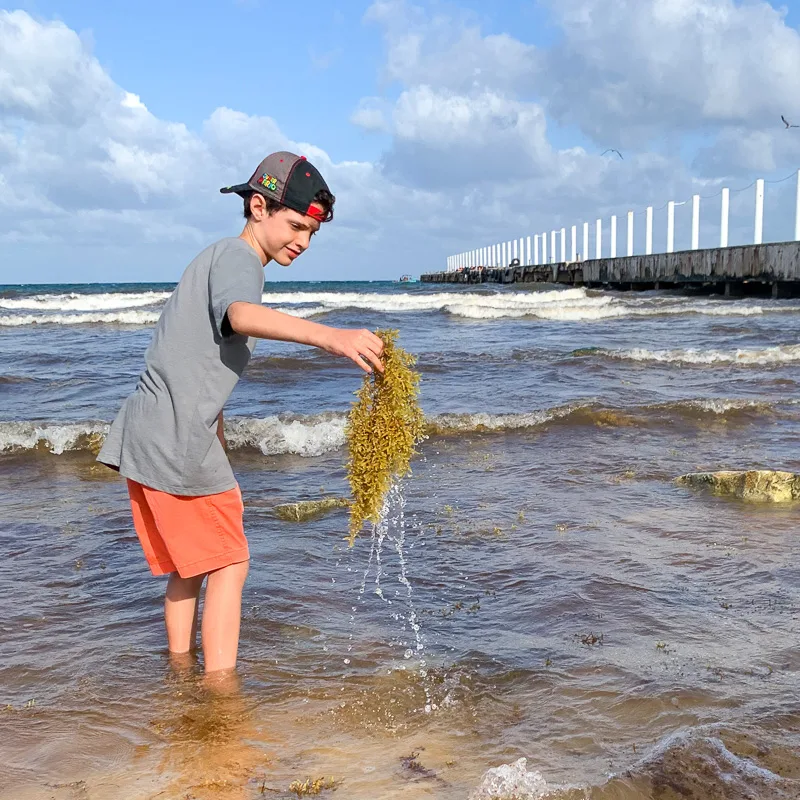Last Updated
Poor Weather And Other Factors Have Postponed The Installation By Over A Month
Tulum is facing further surges of sargassum seaweed unprotected as the barriers supposed to be installed almost two months ago are pushed back once more. The sargassum deposits this year are potentially the worst in five years.

The Mexican Navy has been dealing with the installation of sargassum barriers across Quintana Roo since the end of March. However, poor weather has slowed progress and left Tulum unprotected from the seaweed.
Tulum is one of the most popular cities on the Mexican Caribbean coast and is extremely valuable for tourism. Large sargassum seaweed deposits have the potential to ruin visitors’ vacations and seriously harm the likelihood of return visitors.

With no real protection for the beaches, the onus is taken up by the local businesses to deal with any deposits. Hotels and restaurants have spent hundreds of thousands clearing their strip of sand in the early hours of the morning to allow visitors to enjoy their time on the beach. The investment has eaten into the profits of many businesses, with guests seeing a trickle-down impact in the form of room rate increases. Combined with the added health and safety protocols enacted to fight Covid, the financial effects have been significant.

It’s not been a good week for sargassum deposits. Over the weekend, fifty beaches across Quintana Roo recorded excessive amounts of the unsightly seaweed – the highest amount in four years. Although it has lessened to around twenty beaches since then, the volume is obviously still extremely high.
Notably, the famous resort and theme park, Xcaret, saw its surrounding beaches covered in seaweed and its water turned a murky brown and disappointed many of its guests when it made the decision to close the areas.

According to the sargassum monitoring network “taking more drastic measures at a greater scale to combat sargassum is urgent. Reconsidering the strategy to combat sargassum is a priority. The actions taken up to today haven’t been enough.”
The problems persist despite the Mexican Navy deploying twenty-six ships for the sole purpose of sargassum prevention. Several of the ships are designed to take large quantities of the seaweed from the sea, long before it arrives on the shoreline. But the reality is that these still only remove a fraction of the sargassum. The impact the Navy has had on the sargassum collection has dwindled year on year as the volume increases.

Drastic measures have recently been suggested, including the creation of a 60km long barricade that will push the seaweed in a different direction, protecting the entire coast. The cost of this and how much longer this would take to implement is unclear, and would still be at least a few years before work began.
The sargassum is a unique problem in the Caribbean. The seaweed forms miles out to sea in the Atlantic Ocean, thriving in warmer waters in the summer. As it forms, it creates tangled masses as long as five kilometers. It poses no problems at sea and is incredibly beneficial to the ocean and small animals that adopt it as its own ecosystem.

But as it approaches the Mexican Caribbean, carried on Northerly drifts from Brazil, its impacts become apparent. The typically crystal blue waters of Quintana Roo and other areas of the Caribbean are turned a murky brown, and weak swimmers are at risk of getting their feet trapped in the tangle – although this is rare.

When it hits the sand, it begins to rot, producing an unpleasant sulfur-like smell that drives away tourists in masses. Relaxing on the beach is virtually impossible and many tourists that experience it are put off by the Mexican Caribbean permanently.
It’s not a problem that is likely to disappear, considering the rising sea temperatures help the seaweed All that is clear is that a solution must be found and a cost-beneficial one.
Plan Your Next Cancun Vacation:
Traveler Alert: Don’t Forget Travel Insurance For Your Next Trip!
Choose From Thousands of Cancun and Riviera Maya Hotels, Resorts and Hostels with Free Cancellation On Most Properties
↓ Join the community ↓
The Cancun Sun Community FB group has all the latest travel news, conversations and tourism Q&A’s for the Mexican Caribbean

Subscribe to our Latest Posts
Enter your email address to subscribe to The Cancun Sun’s latest breaking news affecting travelers, straight to your inbox.

Bell
Wednesday 1st of June 2022
This is a great source of iodine and magnesium, like seasmoss. This is a money making business!!!!!!